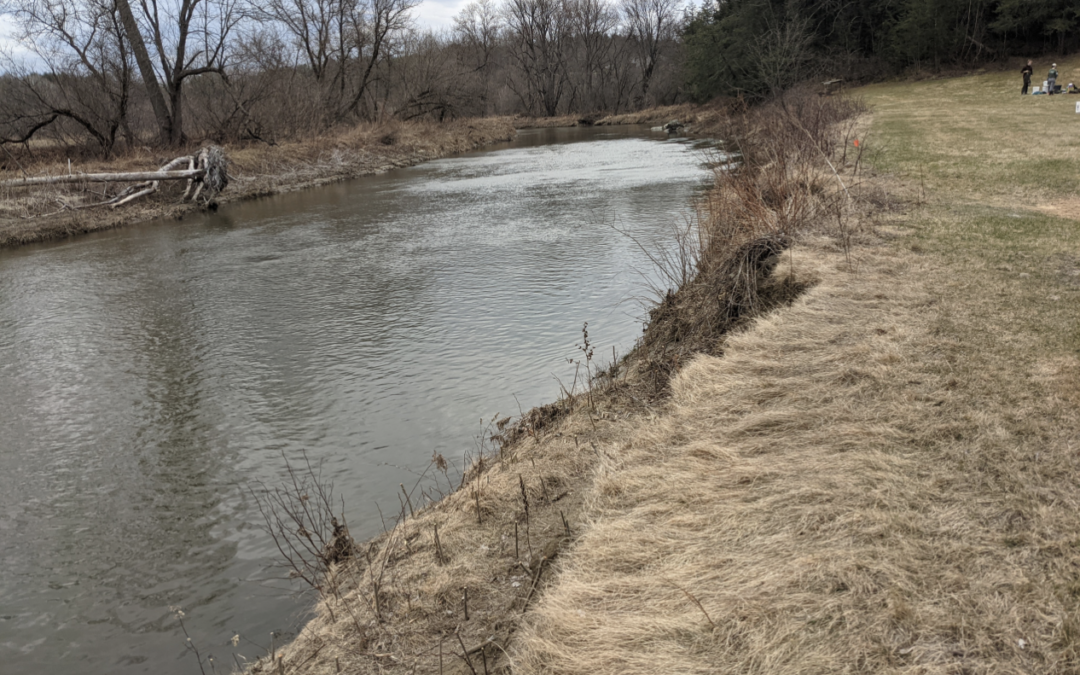By Franklin County Natural Resources Conservation
During the final week of March 2021, the Franklin County Natural Resources Conservation District was out harvesting, trimming, and installing native willow stakes for a streambank restoration project in Fairfax along the Browns River for bank stabilization and improved water quality.
Live staking is a technique that uses cuttings of living woody plants to revegetate unstable soils by adding new root structures. For this project, we harvested native willows from a few sites around Franklin County after securing landowner permission. (Note: It’s important to make sure to harvest willows that are native to Vermont, as many places that have been replanted in the last few decades have used introduced species from other countries that can outcompete native vegetation or be incompatible with the native ecosystems that you’re trying to restore.) We harvested the native willows by cutting stems and branches off of vigorous willow shrubs of 1/2″ to 2″ in diameter using loppers, being sure to follow ethical harvesting guidance of removing no more than 20% of any given plant. We then trimmed up those branches and stems to 18″- 36″ inches in length, meaning that we were able to get an average of 3 to 4 willow stakes per original branch/stem cutting. We kept the bottom ends of the stakes wet in containers over two nights inside our cool and sun-free office basement until we were ready to plant them back into the ground.
On a nice warm day, our team and some volunteers from the Vermont ECO AmeriCorps program went to the project site along 700 feet of one side of the Browns River, a tributary to the Lamoille River, and installed 1100 willow stakes from our harvest a few days earlier. Fortunately for us, the site had loose sandy soils without many rocks, and we were able to install 2/3 – 3/4 of each stake into the ground simply by gently pushing the stakes into the exposed streambank walls in a vertical orientation. When soils are more difficult to work with, it may be necessary to create pilot holes in the ground using mallets and rebar before you are able to insert the willow stake.
The goal of live staking is for those willow stakes to grow their own root networks and propagate other willow shrubs in order to provide bank stability and keep the soil along the river from falling in. Streambanks can be vulnerable to high flows and floods in the spring and fall and to ice flows in the winter and early spring that can carve out banks unprotected by vegetation. The plants will grow roots and shoots (or stems and branches) – providing leaf cover and habitat along the river’s edge in a way that is compatible with the rest of the surrounding ecosystem. Hopefully, the willows will establish themselves well during this current growing season to provide quick stabilization and reduce any further loss of floodplain area for this landowner.
We will be going back out to the project site later this month to plant a 25 foot wide section from the rivers edge with other woody riparian species to further increase streambank and floodplain stability with more root networks. It was important to get the willows planted first and early because you want to make sure to harvest the willows before they wake up from their winter dormancy and start producing buds and leaves. If you wait too long to harvest in the spring, you could be causing damage to the plant you’re harvesting from and the stakes you’re hoping to plant. Willows can also be harvested in the fall once the plants have gone dormant again in the cold, as an alternative to an early spring harvest.
Live staking is a relatively inexpensive and low labor technique used to hold soils in place. This means that it can also be used along agricultural fields that have ditches and streams running through them as part of woody buffers to improve water quality. The plants, like willows, work in two ways: (1) physically holding the soils along the streambank or ditch in place which reduces legacy phosphorus from entering waterways and (2) physically stopping water that runs off fields towards the buffers, which reduces the amount of sediment with phosphorus attached to it from ending up in the streams and reduces the water with dissolved phosphorus in it from entering those streams because of the additional chances to infiltrate into the ground. The willows can use that phosphorus to help build their bodies and further the phosphorus cycle on land.
As a side note, sometimes people want to armor streambanks to prevent erosion with riprap or stone or concrete, which may be appropriate for some landscapes, but using vegetation to stabilize banks can have benefits related to cost, ecosystem health, flood resilience, and stability.
If you are interested in restoring a streambank or preventing erosion using live stakes or other riparian buffer planting techniques, please reach out to us at info@franklincountynrcd.org – Franklin County NRCD would love to work with you!







